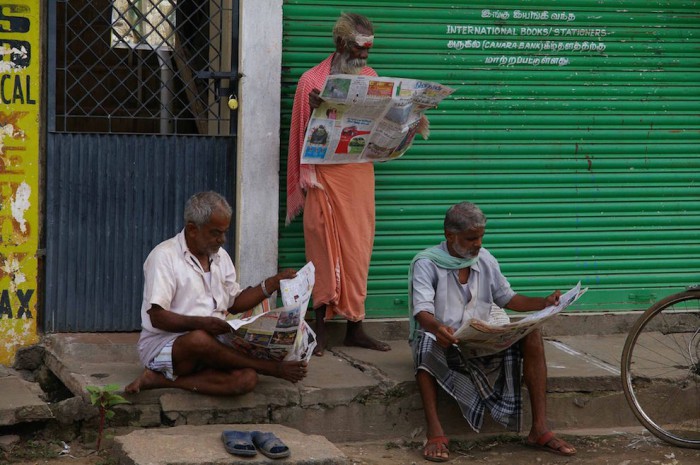
 Over the past seven years, Nikhil Pahwa has built up Indian digital media site Medianama into something like one part TechCrunch, two parts Business Insider. With a healthy dose of policy analysis, the site covers essentially anything tech, Internet, or media in India.
Over the past seven years, Nikhil Pahwa has built up Indian digital media site Medianama into something like one part TechCrunch, two parts Business Insider. With a healthy dose of policy analysis, the site covers essentially anything tech, Internet, or media in India.
I reached out to ask Pahwa about the broader role that these international publishers were playing in the Indian media market. Pahwa — who is currently on sabbatical from the site while he works to secure Indian net neutrality — agreed. Below is a lightly edited transcript of our conversation:
I felt there was a need to do much more, so I started this up. We were sent to expand the charter that paidContent had, which was to look at content and to look at everything digital. So we provide news analysis, perspective — we take part in consultations. We are fairly opinionated — we source a lot of documents to report on, and we report on data. So essentially the approach has been: What can we do to grow the digital ecosystem in India in a manner so it is open, fair, and competitive? We try to be something like The Economist for the digital ecosystem in India, in a sense that we provide perspective on what’s shaping the space.
I think it’s a problem of how they approach their audience. I think that most publications that come to India face this challenge: Are they covering the Indian market for an international audience, or are they covering it for an Indian audience? The Indian audience appreciates a lot of nuance — they want a lot more detail, they want more frequent updates about India. I think with many other publications, especially in the tech space, we see that stories that are important in India are not necessarily important abroad. So I think defining the target audience is important. India Real Time chose to focus on the Indian audience, whereas the newspaper didn’t, so it could always have lower scale.
The other thing you have to keep in mind is that in India, the print news space is very, very vibrant right now, especially in English. There is a lot of competition between the likes of Mint, the Economic Times, Business Standard — and apart from that, there are many new publications that have started online over the last year and a half.
I’m not so sure about how long many of those will last. From a business perspective, India is a very tough market. The agency ecosystem, for example, is quite cut up from what I’ve seen and heard. There are a great deal of publications that do paid news over here, which is publishing sponsored content without disclosures. Even though sites like The Wall Street Journal may not have faced such issues, a large amount of money goes in that direction.
There’s also a problem of the payment cycle in the Indian ecosystem. Typically it takes 150 days to collect a payment after a campaign ends. So the pressure on business to collect payments and the amount of effort required to collect payments makes it even more difficult to run an online publication in India.
There is a difference between what India Real Time is doing and what India Ink [The New York Times’ India-focused site] did. India Ink was about India for an international audience and it lacked the frequency of updates and the focus on India — it was more from a global perspective. India Real Time was actually one of my favorites because of the pace at which they updated and the kind of stuff that they did. They went and got stories that no one was willing to go and get. And thankfully India Real Time is still there, though they’ve scaled it down.But it’s an indication of what an Indian audience wants. They don’t necessarily only want a global perspective and I think this pulling out has more to do with the Journal deciding that they are going to have a largely one-size fits all strategy for the world with a little bit of localization, and that they are saying; “We will have a global edition with a couple of pages of regional content.” I think this move away from India and shutting down the India edition is a part of that plan. I don’t think this has necessarily anything to do with the Indian team not performing or the Indian business not performing, because I think they were here for the long haul in India.
This is not an easy market to operate in. Media businesses in India are not very viable. Most of the publications I have seen, online publications, they are loss-making. That essentially boils down to how you approach a business. For example, we are seven years old. Our approach has always been to be a bottom line and profit-focused business and not one that focuses on scale. Whereas most of these publications — because they are either backed by big money, or they are looking to raise funding — are focused largely on operating on scale, so they will continue to be loss making.
The regional language market is incredibly vibrant right now because there were many untapped markets where people didn’t get newspapers — or they would get really thin editions of news from the main cities, often a day late. So India’s regional language papers, especially those in our national language Hindi, have really over the last five years started expanding deeper and deeper into smaller towns and cities. And that is growing still — if you look at advertising trends, it is growing.
But Google takes about 85 percent of the online advertising market in India. And that’s a really large sum. That’s because no one operates at the scale at which Google does, and I think most Indian publications rely on Google AdSense for at least part of their revenues.
I think most of the new publications don’t really understand these nuances about the Indian market. It takes them a little time to do it. It is possible to run profitable and viable business in India. But you can’t operate with very high expenses. For someone like the Journal or someone like Quartz, they want the best talent, and that comes at a price.
Whereas Quartz had done pretty well by focusing on India for India. Huff Post is doing that as well, and I think that’s a function of the editor who shifted from Quartz to the Huffington Post. Within six or seven months, Sruthijith KK shifted to the Huffington Post India. I think there is a need for having Indian editors to bring an Indian nuance to these publications. We’re seeing a large number of Indian publications started up by journalists who have been senior editors for newspapers because there has been a bit of a turn at the senior level and they feel that it is easier to build online and also own the publication.
Some of them are using the point that they don’t have corporate ownership as a way of positioning themselves in the market. But what I see is that they are replacing that role that magazines played, because magazines are dying in India. While none of the major ones have yet shut down or become online-only yet — that’s still a few years away for us — the role that magazines played for us of providing detail and nuance to news, I think most of the new publications are doing that. The problem is that they will still struggle to get a large number of pageviews. And in a market for advertising where readers are as commoditized as India, they’ll find that advertising revenues do not make up for costs.
There are sites like Scoll.in that are relying on external funding. Scroll is doing really well in terms of audience as well, and they’ve built a strong positioning for themselves as a liberal/left-leaning publication in a country that has voted fairly conservative in the past year. And they have strength in their position in the market. They get a lot of love and they get a lot of hate. And that’s always a good sign for any publication.
There is also very little funding available for online news businesses, unless its of a philanthropic nature.
We’ve seen some of that come through with Founding Fuel, which is focused on entrepreneurship and gets industrial leaders to start blogging and guiding them. They seem to be doing quite well from an editorial perspective.
The other thing you have to keep in mind that Indian publications like The Times of India are also adapting fairly rapidly to the web. So their publication the Economic Times has taken a vertical approach and built out separate sites for different types of verticals. So there is something called ET Tech that competes with Medianama. There’s something called ET Retail that focuses on retail.
The other thing that the Times of India group has done is they’ve tied up a large group of global publishers to sell their Indian audience — in a sense to monetize their websites for India. Over the last two or three years, what the Times of India group, the largest media group in India, has done is to build partnerships with lots of publishers including the Gizmodo, ZDNet — there’s so many — to go and do these partnerships and hired a few Indian guy. (In the case of The Huffington Post, they have a whole team.) But they’ve got about two to three people per website creating India-centric content to show to advertisers a larger bouquet of sites and a larger audience base. They effectively end up becoming aggregators of audience in the same way that Google has done, so they are able to get better rates and have better negotiating ability.
I think that game of skill is what is going to serve them in the longer run, whereas other publications will never have that kind of a base to go to other advertisers.